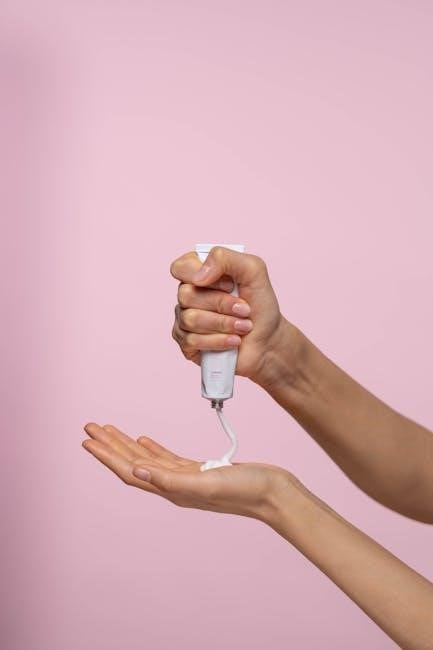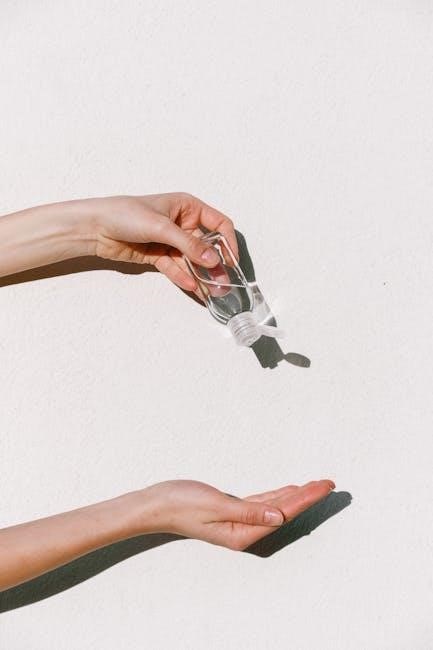The Unna Boot is a specialized medical dressing used in compression therapy to treat venous leg ulcers and manage venous insufficiency. It combines zinc oxide paste with gauze, providing sustained compression and protection to promote healing and improve blood flow. This non-invasive treatment is widely used in clinical and home care settings, offering an effective solution for chronic wounds and skin conditions. Its application involves a spiral wrapping technique, ensuring even pressure distribution and optimal therapeutic benefits. The Unna Boot is a cornerstone in wound care, enhancing venous return and creating a moist environment conducive to tissue repair.
Definition and Purpose
The Unna Boot is a specialized medical dressing designed for compression therapy, primarily treating venous leg ulcers and managing venous insufficiency. It consists of a gauze bandage impregnated with zinc oxide paste, providing a protective barrier and sustained compression. The boot is applied using a spiral wrapping technique, ensuring even pressure distribution. Its purpose is to enhance venous return, reduce swelling, and create a moist environment conducive to tissue repair. This non-invasive solution is widely used in both clinical and home care settings, offering effective treatment for chronic wounds and skin conditions by promoting healing and improving blood flow.
Benefits of Using an Unna Boot
The Unna Boot offers numerous benefits, primarily enhancing venous return and reducing swelling in the legs. Its sustained compression promotes healing by improving blood flow and protecting the wound site. The zinc oxide paste soothes irritated skin, reducing inflammation and discomfort. It creates a moist environment conducive to tissue repair, making it ideal for treating venous ulcers and stasis dermatitis. The boot’s non-invasive nature and versatility in application make it suitable for both clinical and home care settings. Regular use can accelerate recovery, manage exudate, and prevent bacterial growth, ensuring optimal therapeutic outcomes for patients with chronic wounds and venous insufficiency.

Historical Background
The Unna Boot was developed by Dr. Paul Gerson Unna in the early 20th century, initially for skin conditions like eczema and psoriasis, later evolving for venous insufficiency and wounds.
Origins of the Unna Boot
The Unna Boot was developed by Dr. Paul Gerson Unna, a German dermatologist, in the early 20th century. Initially designed for treating skin conditions like eczema and psoriasis, it later evolved to address venous insufficiency and chronic wounds. The boot combines zinc oxide paste with gauze, creating a protective and compressive dressing. Its origins reflect Unna’s innovative approach to dermatological and vascular treatments, laying the foundation for its widespread use in wound care. The Unna Boot’s adaptability and effectiveness have made it a trusted tool in medical practice, with its historical significance rooted in its enduring relevance and clinical adaptability.
Evolution in Wound Care
The Unna Boot has undergone significant evolution since its inception, transitioning from treating skin conditions like eczema to addressing venous insufficiency and chronic wounds. Over time, advancements in materials and techniques have refined its application, enhancing its effectiveness in wound care. The boot’s widespread adoption in clinical settings underscores its adaptability and enduring relevance. Its evolution reflects continuous improvements aimed at optimizing compression therapy, making it a cornerstone in managing venous insufficiency and promoting tissue repair. This progression highlights the Unna Boot’s pivotal role in advancing wound care practices.

Components of the Unna Boot
The Unna Boot consists of zinc oxide paste-impregnated gauze and compression bandages. The zinc oxide paste soothes and protects the skin, while the gauze and bandages provide compression.
Zinc Oxide Paste
Zinc oxide paste is a key component of the Unna Boot, offering protective and soothing benefits for the skin. It is applied as a thin, even layer to the affected area, creating a barrier that reduces inflammation and irritation. The paste helps maintain a moist environment conducive to healing, while its mild antiseptic properties prevent infection. Proper application ensures the paste adheres effectively without causing discomfort; Its role in the Unna Boot is crucial for promoting tissue repair and managing venous insufficiency, as it works synergistically with the compression bandages to enhance therapeutic outcomes.
Gauze and Compression Bandages
Gauze and compression bandages are essential components of the Unna Boot, working together to provide support and therapeutic compression. The gauze is impregnated with zinc oxide paste and applied in a spiral wrapping technique, ensuring even pressure distribution. Compression bandages are then layered over the gauze to enhance venous return and reduce swelling. The gauze protects the wound, while the compression bandages maintain consistent pressure, promoting blood flow and healing. Proper wrapping technique, with 50% overlap, ensures the bandages stay securely in place, providing comfort and efficacy in managing venous insufficiency and chronic wounds.

Preparation and Application
Preparation involves cleansing the leg, applying zinc oxide paste, and wrapping with gauze and compression bandages. Proper technique ensures effective compression and wound protection.
Preparation Steps for Application
Before applying the Unna Boot, thoroughly cleanse the leg with mild soap and water, removing dirt and foreign particles. Dry the skin completely to prevent moisture interference. If wounds are present, clean them with an antiseptic solution and apply a thin layer of antibiotic cream. Flex the patient’s foot to 90 degrees to avoid dressing bunching. Ensure the skin is dry, as moisture can compromise the zinc oxide paste adhesion. Don gloves to maintain sterility and prepare the zinc oxide paste for even application. Proper preparation ensures a clean, dry surface for effective wrapping and compression.
Step-by-Step Application Process
Begin by uniformly applying a thin layer of zinc oxide paste to the affected area. Starting at the base of the toes, wrap the bandage in a spiral pattern, overlapping each layer by approximately 50%. Maintain gentle, even pressure to avoid discomfort or circulation restriction. Ensure the boot extends to just below the knee, never stopping mid-calf. Secure the top edge with medical tape, smoothing it to prevent irritation. Avoid excessive overlap to maintain consistent compression. The spiral technique ensures even pressure distribution, promoting healing and managing venous insufficiency effectively. Follow clinical guidelines to achieve optimal results and patient comfort.
Importance of Proper Technique
Proper technique is crucial for the effectiveness and safety of Unna Boot application. Incorrect wrapping may lead to uneven compression, discomfort, or restricted blood flow. Ensuring even pressure distribution prevents pressure points and promotes consistent therapeutic benefits. Proper application maintains the integrity of the dressing, keeping the wound moist and protected. It also minimizes the risk of complications, such as bacterial growth or irritation. Adhering to clinical guidelines ensures the boot functions optimally, enhancing venous return and tissue repair. Proper technique is essential for achieving the desired outcomes and ensuring patient comfort throughout the treatment process.

Medical Considerations
The Unna Boot is contraindicated in uncontrolled heart failure, untreated infections, or severe arterial insufficiency. Proper patient screening ensures safe and effective application, avoiding complications.
Contraindications for Use
The Unna Boot is contraindicated in patients with uncontrolled heart failure, untreated lower limb infections, or active wound infections. It should not be used in cases of severe arterial insufficiency or when the leg cannot tolerate compression. Patients with sensitive skin or allergies to zinc oxide should avoid its use. Additionally, the boot is not suitable for open wounds with heavy drainage unless properly prepared. Proper patient screening and medical clearance are essential to prevent complications. Ensuring compliance with these guidelines helps avoid adverse reactions and promotes effective treatment outcomes. Always consult a healthcare professional to determine appropriateness for the patient’s condition.
Special Patient Screening
Special patient screening is crucial before applying an Unna Boot to ensure safe and effective treatment. Assess the patient for allergies to zinc oxide or gelatin, as these are key components of the dressing. Evaluate circulatory status, particularly in patients with arterial insufficiency, to avoid worsening ischemia. Inspect the skin for sensitivity or open wounds that may require alternative dressings. Monitor for signs of infection or heavy exudation, which may necessitate delayed application. Ensure the patient does not have uncontrolled heart failure or conditions that contraindicate compression therapy. Proper screening ensures the Unna Boot is applied safely and effectively, optimizing healing outcomes while minimizing risks.

Post-Application Care
After applying the Unna Boot, keep it dry to prevent bacterial growth. Monitor for signs of drainage or odor, indicating potential complications. Advise patients to elevate their leg to reduce swelling and avoid submerging the boot in water. Regular inspection ensures the dressing remains secure and evenly compressed. Proper post-application care promotes optimal healing, prevents infection, and ensures the boot functions effectively. Follow clinical guidelines for best outcomes and patient comfort during the treatment period.
Keeping the Boot Dry
Keeping the Unna Boot dry is essential to maintain its effectiveness and prevent complications. Patients should avoid submerging the treated leg in water, as moisture can weaken the bandage and promote bacterial growth. Instead, the surrounding skin can be gently cleaned with a damp cloth, ensuring the boot remains intact. Monitoring for signs of drainage or odor is crucial, as these may indicate issues requiring medical attention. If the boot becomes wet, it should be replaced promptly to avoid infection and ensure continued therapeutic benefits. Proper drying and hygiene practices are vital to uphold the boot’s integrity and support the healing process effectively.
Monitoring for Complications
Regular monitoring of the Unna Boot is crucial to identify potential complications early. Signs such as increased pain, swelling, or discoloration may indicate issues like impaired circulation or infection. Patients should report any unusual sensations, such as tingling or numbness, immediately. The boot should be inspected daily for looseness or bunching, which can affect compression consistency. If drainage or odor is noticed, the dressing may need to be changed. Monitoring ensures the boot remains effective and safe, preventing adverse outcomes like skin breakdown or infection. Prompt intervention can address complications, ensuring optimal healing and patient comfort throughout the treatment period.

Application Guidelines
The Unna Boot is applied using a spiral wrapping technique, starting at the toes and extending to just below the knee, with 50% overlap for consistent compression.
Spiral Wrapping Technique
The spiral wrapping technique is a cornerstone of Unna Boot application, ensuring even compression and promoting healing. Starting at the toes, the bandage is wrapped upward in a spiral pattern, overlapping each layer by 50% to maintain consistent pressure. The foot should be flexed to 90 degrees to prevent bunching, and the bandage must extend to just below the knee. Gentle, even pressure is applied to avoid discomfort or restricting blood flow. The spiral technique ensures graduated compression, with greater pressure at the ankle gradually decreasing toward the knee. This method enhances venous return, reduces swelling, and creates a protective environment for wound healing. Proper execution of the spiral wrap is essential for the boot’s effectiveness in managing venous insufficiency and promoting tissue repair. Securing the top with medical tape ensures the dressing remains in place, providing optimal therapeutic benefits.
Ensuring Proper Compression
Proper compression is critical for the effectiveness of the Unna Boot in managing venous insufficiency and promoting wound healing. Compression should be applied in a graduated manner, with greater pressure at the ankle that decreases as the boot progresses upward. This is achieved through the spiral wrapping technique, where each layer overlaps the previous one by 50%. The bandage should be snug but not overly tight, avoiding restriction of blood flow. Even distribution of pressure is essential to prevent discomfort and ensure consistent therapeutic benefits. Regular checks are recommended to maintain optimal compression and adjust as needed, ensuring the boot functions effectively in enhancing venous return and reducing swelling.

Clinical Effectiveness
The Unna Boot is highly effective in promoting healing and managing venous insufficiency by improving blood flow and reducing swelling. Its compressive design enhances venous return, creating a moist environment conducive to tissue repair and reducing the risk of complications.
Promoting Healing and Blood Flow
The Unna Boot facilitates healing by creating a protective, moist environment that soothes irritated skin and reduces inflammation. The zinc oxide paste in the gauze calms irritation, while the spiral wrapping technique improves blood circulation. Enhanced venous return delivers oxygen and nutrients to the wound, accelerating recovery. The boot’s compressive design prevents excessive swelling, promoting tissue repair. By managing exudate and keeping the wound dry, it minimizes bacterial growth, fostering a clean environment for healing. Regular use significantly accelerates recovery for conditions like venous ulcers and stasis dermatitis, addressing both symptoms and underlying causes effectively.
Managing Venous Insufficiency
The Unna Boot is highly effective in managing venous insufficiency by providing graduated compression, which enhances venous return and reduces swelling. The spiral wrapping technique ensures even pressure distribution, preventing pressure points. This compression helps alleviate symptoms like leg pain and fatigue by improving blood flow back to the heart. The zinc oxide paste further supports skin health, protecting it from irritation and promoting a conducive environment for recovery. Regular application of the Unna Boot can lead to long-term improvement in venous health, making it a non-invasive and effective solution for managing chronic venous insufficiency and associated conditions.

Common Challenges and Solutions
Common challenges include improper wrapping, causing discomfort or inconsistent compression. Solutions involve proper training, gentle application, and regular monitoring to ensure patient comfort and effective therapy.
Troubleshooting Application Issues
Common issues during Unna Boot application include uneven compression, discomfort, or improper wrapping. To address these, ensure the spiral technique is used correctly, avoiding over-tightening or loose areas. If the boot feels too constrictive, reapply with gentle, even pressure. For patients with sensitive skin, consider alternative dressings or adjust the zinc oxide paste application. Regularly inspect the boot for signs of bunching or slipping and rewrap as needed. Proper training and adherence to guidelines can minimize complications, ensuring optimal comfort and therapeutic benefits for the patient.
Addressing Patient Discomfort
Patient discomfort during or after Unna Boot application can be minimized with proper technique. Ensure the boot is applied with gentle compression, avoiding tight spots that may restrict circulation. If the patient experiences pain or tightness, re-evaluate the wrapping technique and adjust as needed. Padding sensitive areas or using a thinner layer of zinc oxide paste can also reduce irritation. Educate patients on avoiding tight clothing and elevating the leg to enhance comfort. Regular follow-ups with healthcare providers can address persistent issues, ensuring the boot remains effective while maintaining patient well-being and promoting a positive treatment experience.
The Unna Boot is a highly effective treatment for venous insufficiency and wound healing, offering sustained compression and protection to enhance recovery and improve patient outcomes significantly.
The Unna Boot is a specialized dressing combining zinc oxide paste with gauze, providing compression therapy for venous insufficiency and wound healing. It promotes blood flow, reduces swelling, and protects wounds, fostering a moist environment for tissue repair. The spiral wrapping technique ensures even pressure distribution, while proper application and post-care are vital for effectiveness. Patient screening is essential to avoid contraindications like arterial insufficiency or infections. Regular monitoring and adherence to clinical guidelines enhance outcomes, making the Unna Boot a cornerstone in managing chronic wounds and improving patient comfort in clinical and home care settings. Its benefits are well-documented in medical practice.
Final Thoughts on Unna Boot Use
The Unna Boot remains a cornerstone in wound care, offering effective compression therapy for venous insufficiency and chronic wounds. Its non-invasive design, combining zinc oxide paste with gauze, promotes healing by enhancing blood flow and reducing swelling. Proper application and post-care are essential for optimal outcomes. The boot’s suitability for both clinical and home settings makes it a practical solution for patients. With its proven track record in managing venous insufficiency, the Unna Boot continues to be a valuable tool in promoting patient comfort and accelerating recovery. Its enduring relevance underscores its importance in modern wound care practices.

References and Further Reading
- Guidelines for Healthcare Providers: Comprehensive manuals on Unna Boot application and care from medical organizations.
- Recommended Resources: Websites like fighterbrand.com offer detailed application guides and PDF manuals.
Recommended Resources
For comprehensive guidance, refer to fighterbrand.com, offering a detailed PDF manual on Unna Boot application. Additional resources include clinical guidelines from wound care organizations, instructional videos, and medical journals. These materials provide step-by-step instructions, troubleshooting tips, and best practices for healthcare professionals. They also address patient care and compression therapy techniques, ensuring optimal outcomes. Utilize these resources to enhance your understanding and improve application skills, ensuring effective treatment for venous insufficiency and wound management. Always consult reputable sources for the most current and evidence-based practices in Unna Boot use.
Guidelines for Healthcare Providers
Healthcare providers should follow established protocols for Unna Boot application, ensuring proper training and adherence to clinical guidelines. Begin with thorough patient assessment, including wound evaluation and medical history review. Apply the boot using a spiral wrapping technique, starting at the toes and extending to just below the knee. Use zinc oxide paste evenly and maintain consistent compression. Avoid application in cases of uncontrolled heart failure or severe arterial insufficiency. Monitor for signs of complications, such as increased pain or swelling. Document each application and patient response. Provide clear post-care instructions to patients, emphasizing the importance of keeping the boot dry and elevating the leg. Regular follow-ups are essential to assess healing progress and adjust treatment as needed. Continuous education on proper application techniques and contraindications is crucial for optimal patient outcomes.